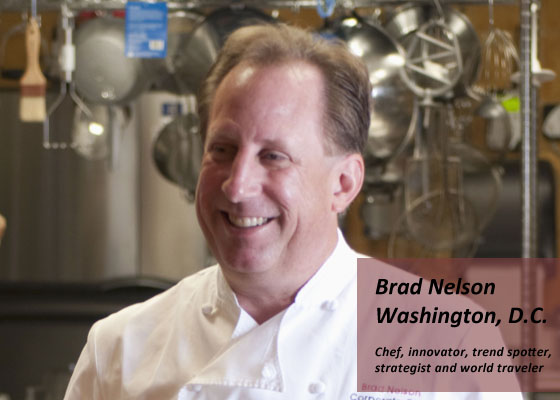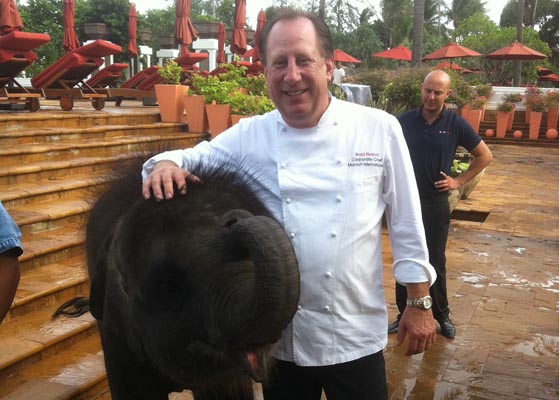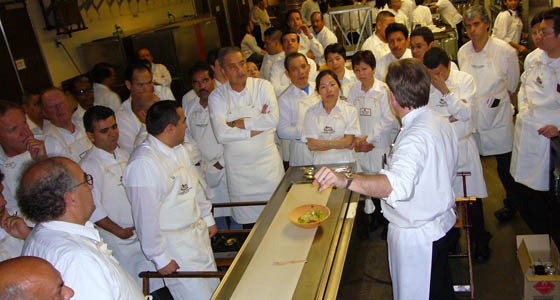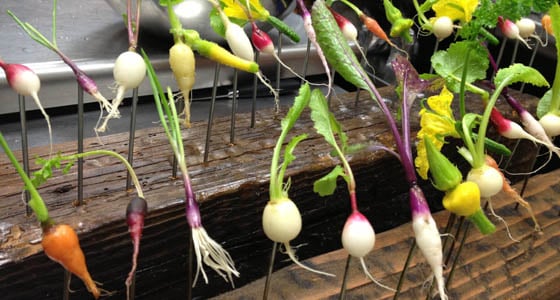Marriott’s Corporate Chef Wants You to Follow the Food
CULINARY POINT OF VIEW
At six years old, Chef Brad Nelson convinced his mom to let him cook, so it wasn’t surprising that his first job at 16 was as a line cook at a Hilton. Now, 36 years later, his love for the hospitality industry and cooking have led him to become Vice President, Culinary and Global Corporate Chef at Marriott International. In this position, Chef Nelson leads a culinary team that focuses on building travel memories through food and beverage experiences. In addition, his passion for sustainability inspired him to create a seafood program that allows guests to know where their food comes from. At the end of the day, Chef Nelson derives the greatest satisfaction from the ability to positively impact your experience at a Marriott-owned restaurant, whether it’s in Hong Kong or Boston.

KELLY HENSEL: What are the major differences between a hotel restaurant and an independent or a chain restaurant?
BRAD NELSON: Well, I think there are operational differences, differences of scale, and differences of focus sometimes. In a large property you may have multiple outlets, multiple concepts whereas a restaurant is generally more singular and narrowly focused on what that particular concept is. However, the similarities are greater than dissimilarities. At the end of the day, what goes off the line and onto the table in front of a guest is a personal experience for that guest. And it doesn’t matter if you’re doing thousands of meals a day, or hundreds, or one—the amount of care and focus is equal on an individual level.
So scale is certainly different. Scope is certainly different. We have thousands of hotels and thousands of restaurants and each one of those have individuals that are focused on taking care of those guests in a way that is unique to that concept in that hotel.
HENSEL: So, you oversee Marriott’s culinary strategy for its 16 brands and 3,800 hotels in 72 countries. How do you create and manage a cohesive brand while highlighting the cultural differences of each location?
NELSON: It’s all about scale. One of the first strategies that we have put in place is to understand what each one of our brands means to the consumers, but also what it means for our portfolio. So one of the first things that I ask myself when we set programs or initiatives in place, is, “What is the DNA for that specific brand and what are the clear test points or guest marks that we need to make sure that we emphasize?”
We’ve got great research on how all of our brands differentiate from the guest’s perspective. So I think the first thing that we put into place is understanding that perspective and understanding what things we should be reinforcing and then within that my role is to align strategic initiatives that reinforce the brand’s perspective as well as incorporating global trends that are changing the marketplace and how that might be interpreted by each brand.
For example, we have some very clear definitions as to how the experience of the Ritz-Carlton differs from the JW Marriott to a Marriott and so forth. But even within all of that, there are some underlining global trends that cross brands. Local food, for example, is something that is clearly on the minds of consumers. This idea that when you travel you garner experiences often times through the cultural interactions in the food that you might eating. The types of presentations and preparations can transcend brands. It may be brought into much more focus in certain concepts or restaurants concepts but it’s certainly something that is not relegated to just one audience. Those are the kinds of things that I work very closely on with the teams globally. I help provide clarity to our leaders in the hotels so they can bring that experience to the guests.
HENSEL: Sustainability is another trend that is pretty important to a lot of consumers. You introduced an innovative sustainable seafood program called Future Fish in 2010. What was the process in getting this program started? What are the challenges for large-scale sustainable programs, such as this one?
NELSON: Sustainability is obviously an important topic and we have some amazing programs in place that deal with, or address, the different sustainable concerns around the world, whether it’s water conservation or energy. Seafood is something that has been, frankly, very near and dear to my heart forever. I grew up in Seattle so I had a very seafood-focused upbringing. The amount of fish and seafood that we [Marriott] purchase and have on the menu can be pretty substantial. I feel and I’ve always felt that there is a role that we can play in that. Our customers as well have asked and told us that they want to know more—and not just about the seafood, but about food in general—but they want to know more about the food that they are consuming.
With sustainable seafood there’s a broad list of challenges we face, such as the fishing practices for specific species. So using resources, such as NGO-published studies, we put together a program that guides our hotels with better information to be able to provide more information to our guests. It focuses specifically on certain species that clearly are at risk, such as Bluefin tuna and sea bass. But it also addresses, in a conscious way, how we work with our vendors and our partners around the world to source better and to be a part of the transition to a more sustainable approach to seafood, whether it be through aquaculture or wild caught.
We feel very strongly that it’s a program that has great impact and value and I think we’ve seen some very positive things from the supply chain around the world. For example, we use a company in the U.K., which I think is really one of the best in the world in how they provide information on the source, the catch, the bycatch impact, and information on where that particular fish was from. And what that does, it actually reinforces to our customer base that we are as concerned as they are about the environmental impact of what we serve on our menus.
HENSEL: For a customer going into one of your restaurants who wants to order seafood, what is the difference in what they see on the menu now, as opposed to what they would have seen before you put this program in place?
NELSON: Well, it’s a little bit more intuitive, so they should be seeing and they will be seeing more species that would be termed as sustainable. So there’s more wild salmon. You won’t see a lot of the endangered species like Chilean sea bass, or Bluefin tuna. Instead, you’ll see different species that might not normally be there. So for example, fluke is something that we see a lot more on menus. It used to be kind of a bycatch, but it’s a great fish. It is something that was not commonly on menus a while ago, but now it is. There’s also more descriptive verbiage on the menu that gives customers an indication that this fish was caught by a particular fisherman or from a particular cove. And if the customer wants more information about that, the hotel, in many cases, will be able to provide that.
I think the overall trend at hand here is that people want to know more about the food that they are purchasing and eating. And so I think the same holds true for other proteins beyond seafood. The fact that there’s a difference in customer preference from antibiotic to non-antibiotic free poultry, for example. Cage-free eggs are another example. If you boil it all down, it’s the fact that there is a need and an appetite for information. People want this information to be able to make choices, whether they’re dining out or in a grocery store.
I think there’s been a transcendence from the way in which people shop for food for home and the way in which they shop for food in restaurants or at events. I think it’s no longer separated as it used to be.

HENSEL: How do culinary trends impact the cuisine in hospitality? Do you think it differs from how independent restaurants approach current trends?
NELSON: Well, I think one of the key differences is that independent chains—whether they have 20 restaurants or 200 restaurants—have one menu. And we have as many menus as we have restaurants. One of the things that we don’t do here is we don’t have a core menu or a menu that is a Marriott menu or the Renaissance menu. There is a style and there’s a distinctive brand perspective, but each hotel and each restaurant is focused really on the community in which they live. They are bringing forward the trends as appropriate to the concept and as appropriate to the area in which they are located.
We try and look at the macro trends and communicate that in a way so that the chefs in our hotels can personalize it so that it makes sense for their region. For example, with sustainability and seafood, it doesn’t mean that we move all of our seafood purchases to tilapia, just because it’s sustainable. There is always a quality reference that reinforces our position in the community for that particular hotel and that particular location. We want to provide people great experiences through food and beverage that reinforces where there are, and has that sense of place, whether it be through ingredients, labor, presentation, or preparation.
HENSEL: In your blog you state that the goal of the culinary team at Marriott is to “build travel memories through food and beverage experiences.” How do you accomplish that?
NELSON: We may develop strategic direction to provide more definitive strategies for hotels to be able to pull that through within their brand. So for example in our JW brand, we focus so much on well-being. So, a lot of our JW hotels have their own gardens. We have a lot of hotels that have beehives and produce their own honey that they then use oftentimes in dessert preparation.
HENSEL: What is your day-to-day like as Vice President Culinary and Corporate Chef at Marriott International?
NELSON: Well, today I have a meeting about a concept design for a particular brand we’re building. My role really is pretty simple. I look at the things that are happening in the industry and look at what we’re doing as a part of that and bringing them as close as we can to what our guests are telling us they want. I identify trends that might be emerging and that we should be aware of and be participating in and also, to some degree, I provide a little bit of clarity as to which trends may be more fads. So, we don’t get too caught up in trying to be on top of the latest trend.
But I think you know, from my standpoint, my role is to look across the landscape, across the globe, and across our collection and find the things that are most compelling for our guests. And put into play some of the structures so that those compelling ideas can actually be brought to life.

HENSEL: It sounds like you spend a lot of time strategizing. Do you get to get in the kitchen at all? Do you travel to the different Marriotts around the world and experience their kitchen environment?
NELSON: With a test kitchen as wonderful as the Marriott headquarters has, I find every excuse possible to cook as much as I can. The greatest part of my job is to travel and spend time with our talented chefs and their outstanding kitchens.
HENSEL: It seems like hotels have been working hard to elevate the customer experience at their restaurants. Where in the past consumers may have viewed hotel restaurants as simply convenient, they are now destinations. Can you comment on this trend in the hospitality industry? How do you work to distinguish Marriott’s restaurants to make them destinations?
NELSON: Strong, focused concepts are what is most important. For too long hotel restaurants tried to answer every need, creating a sense of something for everyone. Now, our restaurants are becoming much more targeted and specific with relevance to a specific concept that carries through all aspects of service, design, and menu.
HENSEL: Having experienced cuisines from around the world, do you have a personal favorite?
NELSON: Personally, I have always loved the food of Central America, especially Mexico. I could live on carnitas tacos. Through my travels in Asia, especially China and Thailand, I have formed a love of the street food culture, and if I had a last meal, it would have to be a street noodle and mango sticky rice from the night market near Soi 22 in Bangkok.

Brad’s Recipe: Quick Pickle
Ingredients
- 1 lb fresh vegetables, evenly cut or sliced
- 1 cup champagne or cider vinegar
- 3/4 cup water
- 1 tbsp Kosher Salt
- 1/4 cup agave syrup
- 1 tsp aromatic seeds of choice (black pepper, mustard, fennel, coriander, etc)
Directions
Bring the brine liquid to a boil for 2 mins, pour over the cut vegetables to cover completely. Place in a stainless steel or glass container, refrigerate overnight for use the next day. Enjoy and store refrigerated for up to one month.


